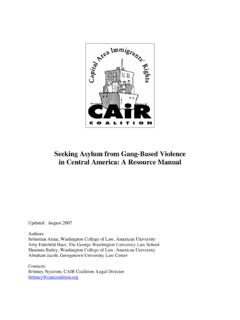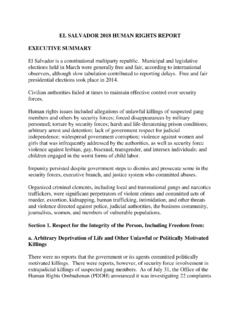Transcription of Writing Citations According to APA - Cambridge College
1 APA Publication Manual 6th Edition 1 2012-2013 Cambridge College Writing Citations According to APA This handout summarizes the main points a student at Cambridge College will need to write in-text and reference Citations for research papers including the Capstone, ILP, and IRP. The information is based on the Publication Manual of the American Psychological Association (6th Edition). A copy of this handout may be found on the Cambridge College website (Library/ Writing Help). Writing a Research Paper .. 2 What is a " citation "? .. 3 What is APA style? .. 3 The in-text citation .. 3 The citation in the References section .. 4 Writing an in-text citation .. 4 Author s Last Name .. 4 1. General guidelines: .. 4 2. If the author s name is included in the sentence: .. 4 3. If the author s name is included in parentheses after the sentence.
2 4 4. Citing a quotation which has 40 or more words: .. 5 5. Citing a summary or paraphrase: .. 5 6. Two authors: .. 6 7. Three, four, or five authors: .. 6 8. Six or more authors: .. 6 9. Group or organization as the author: .. 7 10. Publication with no author and no organization:.. 7 11. Personal, unpublished communication .. 7 12. Citing an author who was cited in someone else s paper: .. 7 Date of publication .. 8 13. General guidelines: .. 8 14. Date for a personal, unpublished communication: .. 8 15. The date includes a year, month, and day: .. 8 16. No date is given: .. 8 17. The document was retrieved from the internet: .. 8 APA Publication Manual 6th Edition 2 2012-2013 Cambridge College Page number .. 8 18. General guidelines: .. 8 19. Online articles from a published source (such as a periodical).
3 9 20. Online articles without page numbers but with paragraph numbers: .. 9 21. Online articles with no page or paragraph numbers: .. 9 22. Online articles with no page numbers or paragraph numbers: .. 9 Writing a Reference citation .. 9 23. General Guidelines for the References page: .. 9 Author s name ..10 24. General guidelines: ..10 25. Two to six authors: ..10 26. Seven or more authors: ..10 27. No author given: ..11 28. No author or organization: ..11 29. Article in an anthology (a book with articles by many authors): ..11 Date of publication ..11 30. General guidelines: ..11 31. The date includes a year, month, and day: ..11 32. No date is given: ..12 33. General guidelines: ..12 34. Should the name of a book be italicized or underlined? ..12 35. Should the title of an internet document be italicized (or underlined)?
4 12 Publication information ..13 36. Books: ..13 37. Article from a journal or newspaper: ..13 38. Chapter in an anthology: ..14 39. Documents retrieved electronically: ..14 APA Web Sites ..15 Example of a References page ..15 Writing a Research Paper The process of Writing a research paper includes reading what others have written on the topic. Students must include discussion of what other scholars have said in their own papers. This may be done as a summary, a paraphrase, or a quotation. However, APA Publication Manual 6th Edition 3 2012-2013 Cambridge College because these are not the student s own thoughts or words, credit must be given to the authors who developed the thoughts and wrote the words: this is referred to as citing the author. If the student does not give appropriate credit to the author, the student can be accused of plagiarism, a very serious offense.
5 What is a " citation "? When a writer uses facts, information, ideas, or quotations from someone else s Writing , the writer must tell the readers where this information came from. This is called a citation . Cite is the verb for giving the citation . It is extremely important that the writer gather the information needed for Citations as he/she uses the publication! Do not plan on going back to the source later for the details needed for a citation . Record the following information for each source document: title of document author s name (if given) as well as editor s name (if given) date of publication (this is not the date of retrieval from the internet for online documents) publisher and place of publication (for a book) name of periodical or newspaper in which the article was found, plus the date of the publication, its volume number, issue number, and page numbers of the article URL (http address) for articles from the internet DOI Digital Object Identifier (if one has been assigned to an electronic source) Sometimes it is best to copy pages of the document on which this information is located so that the information will be readily available for the Writing of both in-text and References Citations .
6 What is APA style? There are a number of styles for preparing manuscripts, which include the instructions for Writing Citations . For example, both the American Psychological Society (APA) and the Modern Language Association (MLA) have prepared guidelines; The Chicago Manual of Style (CMS), 16th ed., is also a standard. The standard usually used at Cambridge College is the APA style, which is the standard for academic papers in the social sciences such as psychology and education. In an APA style paper, the citation is given twice in the paper: in the body of the text and on a separate page titled References. The in-text citation This is located within the body of the paper and gives enough information for a reader to find the publication on the References page of the document. Information in the in-text APA Publication Manual 6th Edition 4 2012-2013 Cambridge College citation includes the author s name, date of publication, and if the cited material is a quotation the page number.
7 The citation in the References section APA uses the title References for the pages of complete publishing information for all in-text Citations in the paper. The References page is near the end of the paper; only the Appendix (if the paper has one) goes after it. The reference citation for books includes the author s name, date of publication, name of the book, and publishing information. There are slight differences, however, between Citations for books, articles from print sources such as periodicals and newspapers, and documents retrieved from the internet. These differences in citing are addressed in this handout. References only include information for sources cited in the text. (A bibliography is a list of every book and article the writer looked at whether an in-text citation is included in the paper or not).
8 Writing an in-text citation In-text Citations include: Author s last name Year of publication Page number or paragraph number (for quotations) Author s Last Name 1. General guidelines: Give only the author s last name in the in-text citation . The author s name may be included as part of the sentence or after the sentence in parentheses. 2. If the author s name is included in the sentence: Always use the past tense or present perfect tense to introduce the summary, paraphrase, or quote: As Green (1994) stated, if children were fed adequately at home, schools would not need lunch programs" (p. 25). 3. If the author s name is included in parentheses after the sentence: Separate the author s name from the date of publication with a comma and one space. (Green, 1994) If the citation is for a quotation, separate the date of publication from the page number with a comma and one space.
9 (Green, 1994, p. 25) APA Publication Manual 6th Edition 5 2012-2013 Cambridge College Note that the final punctuation for the sentence goes after the closing parenthesis. As one expert stated, if children were fed adequately at home, schools would not need lunch programs (Green, 1994, p. 25). 4. Citing a quotation which has 40 or more words: The above examples are for quotations less than 40 words long. If a quotation has 40 or more words, it must be written as a block quote using the long quote form. Set the quote off in a block by starting a new line and indenting five spaces from the left margin. The quote must still be introduced as a quote, such as: As Romain (1998) stated: No quotation marks are used. Double space the entire quotation. End the last sentence with appropriate punctuation.
10 Put the page number in parentheses right after the long quote. Do not put a period after the parentheses. While it is necessary to give attention to the adolescent who feels isolated, attention should focus equally on those who are at least partially responsible for the isolation. Recent research has focused on the attitude and behaviors of adolescent groups, specifically those of cliques. Cliques form for a variety of reasons, but Romain (1998) notes the safety is chief among them. Romain states: Being cliquey can make the clique feel secure (because being part of a group is a kind of protection). Think about how wild dogs form packs in the wilderness, or how gangs hang out in the streets. Cliques aren t as dangerous, but the idea is the same. They stick together because there s safety in numbers.





